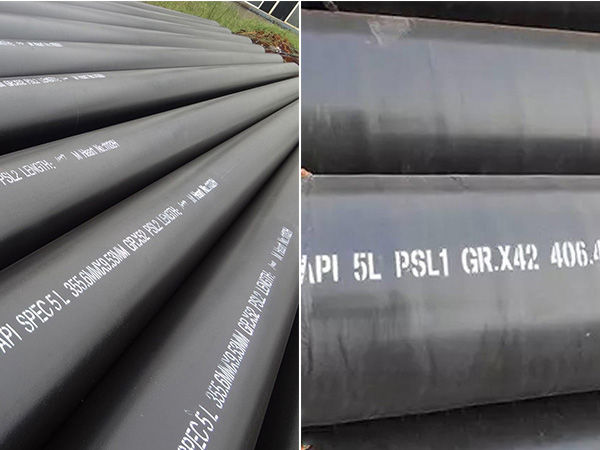
API 5L PSL2 is more stringent, with higher quality requirements for steel pipes, including higher strength and toughness, as well as stricter control of chemical composition. It is suitable for more demanding working environments such as high pressure, high temperature or corrosive media. And the steel plates or steel coils used for PSL2 grade shall not have any repair welding. The additional test requirements of PSL-2 include CVN testing, non-destructive testing of seamless products, SR15 certification, and mandatory traceability throughout the production process.
PSL1:
|
Chemical composition |
Seamless pipe |
Welded pipe |
|
C(max) |
0.28% |
0.26% |
|
Mn(max) |
1.20% |
1.20% |
|
P(max) |
0.03% |
0.03% |
|
S(max) |
0.03% |
0.03% |
|
V(max) |
a,b |
b |
|
Nb(max) |
a,b |
b |
|
Ti(max) |
b |
b |
| Note |
a.NB + V ≤ 0.06%, b.Nb + V + Ti ≤ 0.15% |
|
PSL2:
|
TYPE |
C(max) |
Mn(max) |
P(max) |
S(max) |
Si(max) |
V/Nb/Ti(max) |
|
Welded pipe(BM) |
0.22% |
1.20% |
0.025% |
0.015% |
0.45% |
0.06%/0.05%/0.04% |
|
Seamless pipe(BR) |
0.24% |
1.20% |
0.025% |
0.015% |
0.40% |
0.06%/0.05%/0.04% |
The difference between mechanical properties and impact toughness
PSL1: Only the minimum tensile strength and yield strength are required, with a yield strength of ≥ 35,500 psi and a tensile strength of ≥ 60,200 psi. Impact tests are not required.
PSL2: In addition to the minimum value, there are also maximum yield strength and tensile strength limits. Yield strength: 35,500-65,300 Psi; Tensile strength: 60200-95000 Psi. The tensile strength of the weld seam of the welded pipe shall not be less than 60200 psi. Charpy impact toughness test required: Most grades (except X80) must be conducted at 0 °C, including longitudinal ≥41 J and transverse ≥27 J; The X80 grade is higher, requiring ≥101 J in longitudinal direction and ≥68 J in transverse direction.
Inspection and manufacturing control
Non-destructive testing (NDT)
PSL1: Proceed as required, no mandatory requirements.
PSL2: Each pipe must undergo NDT and hydrostatic tests. Alternative methods cannot be used.
Impact and hydrostatic tests
PSL1: You can choose whether to conduct an impact test or not.
PSL2: Each steel pipe must undergo impact and hydrostatic tests.
Heat treatment and welding control
PSL1: Welding heat treatment is only required for high grades (>X42).
PSL2: All grades of steel pipe welds must be heat-treated, and high standard manufacturing processes such as welding frequency (resistance welding ≥100 kHz) and prohibition of laser continuous welding are specified.
Applicable grades and size ranges
PSL1: Covering A25 to X70, with dimensions ranging from 0.405 to 80" OD, it can handle multiple ends (threads, slopes, etc.).
PSL2: Covers B to X80 (some manufacturers support up to X120), typically ≥2.375" (about 4.5 cm), usually Plain end. There are more restrictions on the welding method.
Summary and comparison
PSL1: It is suitable for general use, with relatively loose parameter Settings, lower inspection requirements, and weaker controllability.
PSL2: It belongs to a high safety level, strictly controlling chemical, mechanical, manufacturing and inspection standards. It is suitable for oil/gas transportation projects with high pressure, harsh environments or strict regulatory requirements.